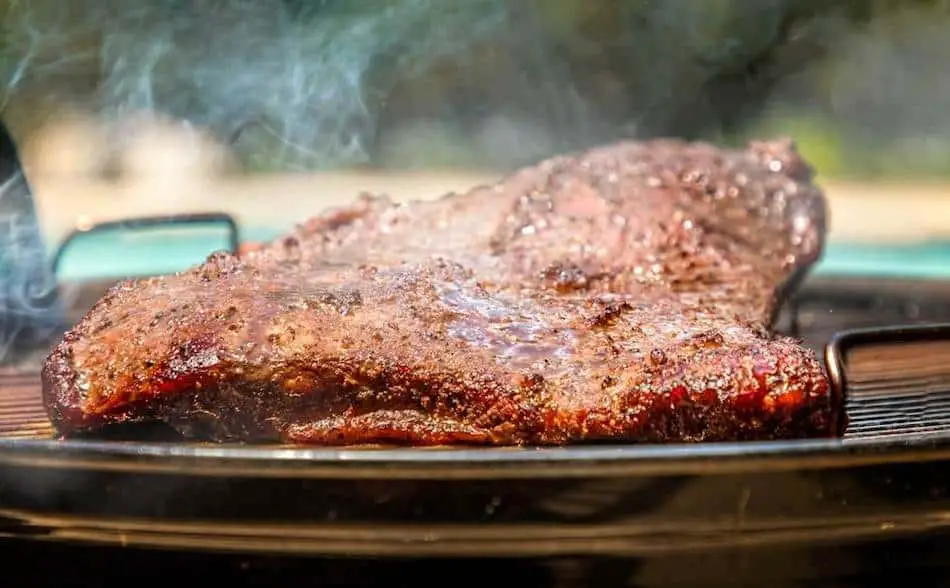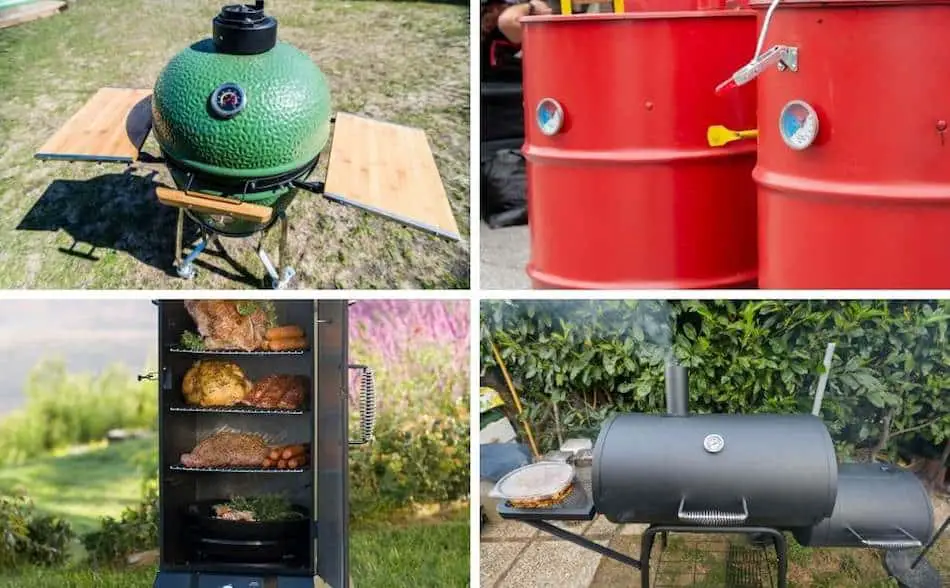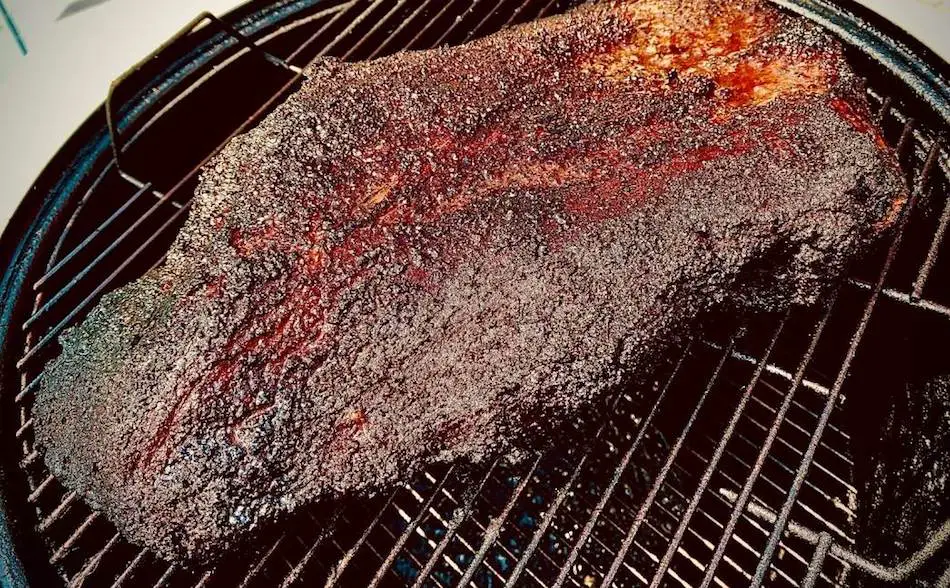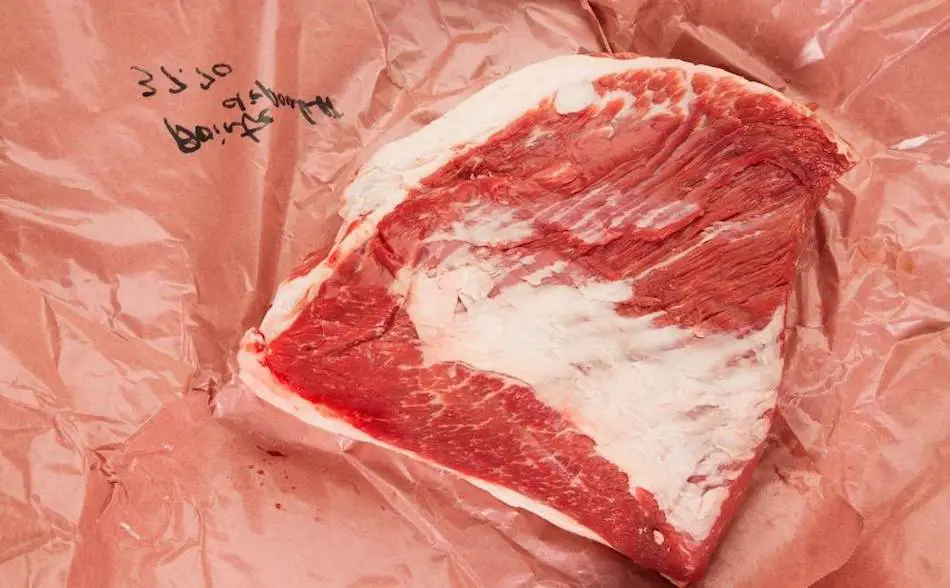
The brisket fat-cap-up or fat-cap-down is an age-old debate, probably up there with wrap or no wrap. I always place the fat-cap-down, but after I did some research on the topic, it surprised me to find out how many pitmasters go fat-cap-up. So which way is better? Turns out the way you place your brisket on the grill depends on your smoker and your preference.
If the heat source is below the meat, lay the brisket fat-cap down to protect it from being over-exposed to the heat. The layer of fat will shield the meat and prevent the brisket from drying out. If the smoker’s heat source is above the meat, position the meat fat-cap facing upwards.Whether you smoke your brisket fat-side-up or fat-side-down will depend on the type of smoker you’re using. However, you can experiment positioning the brisket both ways, because there are some interesting theories that have merit. Below are the pros and cons of each side of the debate.
The Hottest Debate in the World of Barbecue
There is a longstanding debate in the barbecue community over the best way to position the brisket during the smoking process: fat side up or fat side down. Pitmasters, barbecue experts, and competition pitmasters have all weighed in on this debate, offering their own quotes, opinions, and advice on the subject.
One argument in favor of cooking the brisket fat side up is that the fat helps to baste the meat as it cooks, adding flavor and moisture to the meat. For example, pitmaster Aaron Franklin has said,
“I think cooking it fat-side up is the way to go, because the fat will baste the meat as it cooks and help keep it moist.”
Aaron Franklin
Cooking the brisket fat side up may also result in a more tender finished product, as the fat can help to break down the connective tissues in the meat.
On the other hand, proponents of cooking the brisket fat side down argue that this position allows the meat to cook more evenly and results in a nicer bark (the crispy, flavorful outer layer that forms on the surface of the meat during the smoking process). For example, pitmaster Malcolm Reed has said,
“In barbecue competitions, I cook my brisket fat side down because the finished product will look better for the judges. However, when I’m cooking at home, I go fat-side-up. When you lay the brisket fat-side-up, the underside of the brisket won’t look as good because parts of the meat may become charred. When the brisket is cooked fat-side-down, the meat side will cook more evenly, and have a nicer bark.”
Malcolm Reed
At the end of the day, the choice of whether to cook the brisket fat side up or fat side down is a matter of personal preference and may depend on the specific goals of the cook, such as achieving a particular flavor or texture. Some pitmasters recommend experimenting with both positions to see which produces the best results for your particular smoker and cooking style. As pitmaster Myron Mixon has said, “There’s no right or wrong way to do it. Just do what works for you.”
Key Points
- The placement of a brisket on the grill, fat-side-up or fat-side-down, can affect the cooking process and the final result.
- When the heat source is below the meat, placing the brisket fat-side-down can help protect the meat from being over-exposed to heat and prevent it from drying out.
- On the other hand, when the heat source is above the meat, such as with offset smokers, placing the brisket fat-side-up can allow the fat to render and drip down onto the meat, helping to keep it moist and flavorful.
- Other factors that can affect the moisture content of a brisket include low-and-slow cooking techniques such as wrapping, basting, brining, temperature control, and marbling.
- Placing the brisket fat-side-down may slow down the cooking process, prevent the meat from burning, insulate the meat and help retain moisture, create more smoke (for charcoal smokers), create a harder bark on the meat side, and taste better.
- Placing the brisket fat-side-up may make it easier to slice, make for a more attractive presentation, and allow the fat to render more evenly.
- The best approach will depend on the type of smoker being used and personal preference, and it may be helpful to experiment with both fat-side-up and fat-side-down to find the method that works best for your setup.
Why Brisket Placement Matters
Brisket is a sizeable chunk of meat that will spend most of the day in the smoker, so preventing it from drying out is going to be your biggest challenge. First, you need to identify the direction of the heat source. One way to prevent moisture loss is to place the brisket fat-side-down with the thickest part facing towards the heat source. However, this isn’t what will make or break your brisket. Low-and-slow cooking practices such as wrapping, basting, brining, temperature control, and marbling play more important roles, but we want to do everything within our power to minimize moisture loss, and the way you position the brisket on the grill will help.
“How To Reheat Brisket Leftovers (Sous-Vide, Oven, Grill & Microwave)”
But Much Depends On Your Smoker
Most smokers have a heat source at the bottom of the pit. Charcoal smokers such as kettle grills, ugly drums and kamados will have a fire at the bottom, and many vertical pellet grills and gas smokers also have the heat coming from below the meat. Electric smokers cook meat with indirect heat, so the direction of the brisket will not make much difference.

Brisket Fat Side Up: Pros and Cons
| Pros: Fat Side Up | Cons: Fat Side Up |
| Bastes the meat (a theory) | More seasoning will drip off |
| A more beefy flavor | Less smokey flavor |
| Practiced by pitmasters Aaron Franklin and Malcom Reed. | Softer bark on meat side |
| Cooks faster (if you want a fast brisket) | More rub and seasoning will wash off |
| Cooks fast ( a con if you prefer low and slow) |
Brisket Fat Side Down – 7 Good Reasons
There are pros and cons with both brisket fat side up and fat side down. I’ve done extensive research in the barbecue and meat smoking community, and there seem to be more reasons to smoke brisket fat-side-down. As always, experiment with both methods and see which you prefer. Below are 7 of the main reasons to lay your brisket fat side down.
1. Fat Side Down Slows Down The Cooking Process
If you’ve been cooking low and slow for a while, you would know that one of the most important practices is to slow down the cook as much as possible. We want the brisket to sit in the smoker at a low temperature for 10 to 18 hours or longer. Brisket is a tough cut of meat with a lot of connective tissue, and time is the only way to break down the brisket’s sinew. If the brisket cooks too fast, the meat will taste chewy.
So we need to use everything at our disposal to slow down the cooking process. Techniques such as mopping and spritzing, temperature control, using a water pan, cooking with indirect heat, and placing the meat fat side towards the heat will all help slow the cook.
2. Fat Side Down Prevents the Meat From Burning
If you face the meat side of the brisket towards the fire or heat source, it may dry out the brisket if you’re not careful. If you don’t rotate the meat side of the brisket, it may char or burn in some sections. By placing the brisket fat-side-down, the fat will protect the meat from burning. This is especially important when using a charcoal smoker where the fire can be unpredictable.
Charring isn’t as much of a problem with electric smokers, pellet grills and a gas smokers because the heat is easier to control, however the edges may still burn a little. The heat from an offset smoker comes from the side, so the direction of the brisket fat doesn’t matter as much, however some charring can still occur if you don’t place the meat in the cool-zone, or if you don’t rotate the meat.
3. The Fat Insulates the Meat and Helps Retain Moisture
If the meat side of the brisket is exposed to high heat, it may draw out all the moisture and it will become dry. When the brisket is fat-side-down, the meat side won’t face the full force of the heat, but the fat will absorb much of the heat. Even a 1/4 inch of fat will be enough to provide a small barrier that can help prevent the meat from burning and drying out.
There are several other things you can do to prevent your brisket from drying out, and placing your brisket fat-side-down is only one of many good practices. Dry brining, marbling, spritzing, wrapping and temperature control also play a role in reducing moisture loss. Smoking a brisket has so many variables, so all you can do is balance those variables as much as possible.
4. Fat Facing Down Creates More Smoke
In addition to wood and charcoal, another source of smoke when cooking a brisket is the fat that melts and drips onto the fire. This is particularly relevant for charcoal smokers, which have a fire at the bottom of the smoker and rely on burning wood or charcoal to produce smoke. When the brisket is placed on the cooking grate with the fat side facing down, more fat will drip onto the fire, which can create additional smoke.
However, it is important to be aware that too much of this type of smoke can cause the brisket to taste bitter. This can be a problem if the meat is exposed to this type of smoke for an extended period of time, as the bitter flavors can build up and overpower the natural flavors of the meat. To avoid this problem, it is important to monitor the level of grease smoke being produced and make adjustments as needed. This may involve adjusting the temperature of the smoker, the placement of the meat, or the amount of wood or charcoal being used to produce smoke.
5. Fat Down Makes Better Bark
The bark is a key feature of a smoked brisket and is responsible for much of its flavor and texture. The bark is the hard, crispy outer layer that forms on the surface of the meat during the smoking process and is created through a combination of the seasoning fusing to the meat, the smoke, and the dehydrated meat.
When the brisket is cooked fat side down, the lean underside of the meat is facing upwards and has a good chance of dehydrating and drying out. This allows the bark to form more easily and results in a harder, crispier texture. Also, when the brisket is cooked fat side down, the fat does not drip down onto the surface of the meat and wash away the seasoning, allowing the rub to fully fuse to the meat and contribute to the development of a flavorful bark.
Another thing to remember, when the brisket is cooked fat side up, the fat may drip down onto the surface of the meat and wash away the seasoning, resulting in a less flavorful bark. Additionally, the meat may not have the opportunity to dehydrate as much, leading to a softer, less crisp bark.
“Should I Wrap My Brisket In Paper or Foil? (Plus We Compare 11 Different Papers)”
6. Fat Side Down Tastes Better
Placing the brisket fat side up during the smoking process can cause a few problems. Firstly, the fat will drip down onto the underside of the meat, washing off any seasonings that have been applied to the meat. This can lead to a loss of flavor in the brisket, as the rub (a mixture of spices applied to the meat) plays a crucial role in the overall flavor profile and bark development.
The bark is the crispy, flavorful outer layer that forms on the surface of the meat during the smoking process, and it is created in part by the fusion of the rub to the meat. When the fat drips onto the underside of the meat and washes off the rub, it can prevent the rub from fully adhering to the surface of the meat, resulting in a less flavorful bark. To avoid this problem, it is recommended to place the brisket fat side down during the smoking process to allow the fat to protect the underside of the meat and keep the rub in place. This will help to ensure that the rub fully fuses to the meat and contributes to the development of a flavorful bark.
7. Fat Down Looks Better
In barbecue competitions, pitmaster Malcolm Reed often cooks his brisket fat side down because it produces a finished product that looks better for the judges. This is because the fat side down position allows the meat to cook more evenly, resulting in a nicer bark (the crispy, flavorful outer layer that forms on the surface of the meat during the smoking process).
When the brisket is cooked fat side up, the underside of the meat may become charred or unevenly cooked due to the fat dripping down onto the surface of the meat. However, when cooking at home, Malcolm Reed opts to cook his brisket fat side up. This is likely because the fat side up position allows the fat to baste the meat as it cooks, adding flavor and moisture to the meat. Cooking the brisket fat side up may also result in a more tender finished product, as the fat can help to break down the connective tissues in the meat.

Brisket Fat Cap Up
Many people practice fat-side-up because that’s the way brisket master Aaron Franklin smokes his briskets. The only reason Aaron lays his brisket fat side up is because he uses offset smoker where the firebox is directly above the meat, so it’s a different story.
Believers in the fat-side-up theory mistakenly believe the fat works as a type of basting for the meat and keeps the brisket moist. There is an element of truth to this theory, but it has mostly been debunked. With the brisket fat-side-up, most of the fat will drip down and only baste the sides of the brisket and fall into the drip tray, leaving the bottom of the meat dry. So a small amount of basting will occur, but it will not make an enormous difference. If you want more fat basting, put your fat trimmings to good use and place the on the rack above your brisket.
“Brisket Unwrapped: Tips For Smoking A Naked “No Wrap” Brisket”
How to Get Extra Fat Basting
A common practice among pitmasters is to put aside some fat trimmings and lay them on a rack above the brisket. This especially works well if you lay the brisket fat side down because the underside of the meat will get some extra fat basting. This technique allows you to get the benefits of both sides of the fat up or down debate. Another popular practice is to place a tray of beans underneath the meat for an extraordinary boost of flavor.

Brisket Point Towards Heat
It’s a good idea to place the thickest part of the brisket (the point) towards the heat source. We want the brisket to cook evenly, so by placing the thickest part towards the fire, it will protect the thinner end (the point) from burning. The thicker point also contains more internal fat (marbling), so it is better able to retain moisture whereas the thinner flat will dry out easily.
“How To Smoke A Brisket Flat (Without Drying It Out)”
How Much Fat Should I Trim Off Brisket?
We should trim most of the fat cap from the brisket when preparing the meat prior to smoking. Using a sharp knife, leave about 1/4 of an inch fat on top of the brisket. If you leave too much fat on top, the smoke won’t be able to reach the meat, so you won’t get that nice smokey flavor. Also, applying rub on the top layer will be a waste of time because the fat will block the rub from flavoring the meat.
Thick fat will also interfere with dry brining, an important step in the brisket preparation. Dry brining is simply rubbing salt into the brisket 2-24 hours prior to smoking. The dry brine not only flavors the meat, but the salt helps the meat retain moisture during the long cook. If the brisket has a thick layer of fat on top, then the salt won’t be able to penetrate the meat and therefore contribute to moisture loss.
A thick fat-cap will also prevent good bark formation on top of the brisket. Bark is formed by the drying of meat flesh and rub, so a fat layer will stop the bark forming. With a nice thin 1/4-inch layer of fat, the rub and smoke will flavor the meat, and the fat will provide a layer of protection and help keep the brisket moist and juicy. When selecting a brisket, try to buy one with will less fat to reduce waste.
Score Brisket Fat Before Smoking
Another popular practice is scoring the fat on top of the brisket. Scoring is done by taking a knife and cutting a cris-cross pattern into the fat, but without marking the meat. The incisions into the fat will allow smoke, rub and salt to reach the meat easier. Scoring brisket isn’t essential, but it’s something you can experiment with and it makes the brisket look fancy in the smoker.
“Tallow On Brisket – How To Make It (And Use It On BBQ)”
Brisket Fat Side Up or Down on a Pellet Grill?
Not all pellet grills are the same, so how you place your brisket on the grill will depend on the direction of the fire pit. If you have a vertical pellet grill like a PitBoss, place the brisket fat side down so the fat can shield the meat from the heat. If the firebox is higher in the smoker, place the brisket fat side up.
Brisket Fat Side Up or Down on an Electric Smoker?
Electric smokers cook brisket with an indirect heat, so the brisket placement on the grill isn’t as important as other smokers. However, the heat does still come from a particular direction, so it’s better to place the fat cap towards the heat.
What Do The Pitmasters Say?
The best way to settle the debate is to compare the two methods with a side-by-side taste test. Check out this video by Meat Church where they compare briskets prepared different ways.
My Favorite Brisket Tools
Thanks for checking out this article. I hope you learned a few things. Here are some of my favorite tools I use when smoking brisket that may be useful to you. These are affiliate links, so if you decide to purchase any of these products, I’ll earn a commission. But in all honesty, these are the tools I recommend to my family and friends who are just starting out.
Meat Injector: Injecting meat is a great way to take your barbecue to the next level and help you make competition-style brisket. An injector is the only way you will be able to get flavor and moisture into the middle of the meat. The Beast Injector is a stainless steel injector that is sturdy and affordable. Check the latest price on Amazon here.
Brisket Marinade: The best injection solution on the market is the Butcher BBQ Brisket Injection. This marinade is used in competitions and is made by World Barbecue Champion pitmaster, Dave Bouska. You can find the marinade on Amazon here.
Butcher Paper: Wrapping brisket in butcher paper has become a huge trend in barbeque thanks to Aaron Franklin. Wrapping your brisket in paper will give you a nice brisket bark. However, you can’t just use any old paper, it has to be unwaxed, food grade paper. You can find it on Amazon here.
Brisket Rub: These days I make my own rub when possible, but I always have a few pre-made rubs for when I’m running low. Barbecue guru Malcom Reed produces Killer Hogs, one of the best brisket rubs I’ve found over the years. Another great rub is Slap Yo Daddy, made by brisket master and multiple World Barbecue Champion, Harry Soo.
Meat Thermometer: There are dozens of fancy thermometers on the market, but I still use my trusty TP20. For around $50, I have a high-quality meat thermometer with two probes, and can track the temperature of my smoker with one probe, and my meat with the other probe. The ThermoPro TP20 is an Amazon Best Seller because it’s the easiest thermometer to operate, is durable, highly accurate, and comes with pre-programmed meat settings.
Instant Read Thermometer: Arguably, the second most important tool you need is a fast and accurate instant-read thermometer. These tools play an important role in the latter stages of the cook when the meat needs regular checking in multiple areas. I use the ThermoPro TP19 because it can do everything a ThermaPen can do, but for a fraction of the cost. You can check out the TP19 on Amazon here.
Advanced Thermometer and Automatic Temperature Controller: Once you’re ready to take things seriously, the FireBoard 2 Drive is a six-channel Bluetooth/Wi-Fi thermometer that can monitor up to 6 pieces of meat, control and graph your cook sessions on your smartphone, and attaches to an an automatic blower that will convert your charcoal smoker to a set-and-forget. This is one of the most advanced meat thermometers on the market. You can check it out on the FireBoard website here.
Want More Brisket Articles?
Want to try something different? Tri Tip is an awesome smoking meat that you should try out: How To Smoke Tri Tip

